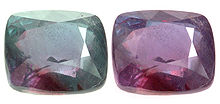- Nils Gustaf Nordenskiöld
-
The title of this article contains the character ö. Where it is unavailable or not desired, the name may be represented as Nils Gustaf Nordenskiold.
Nils Gustaf Nordenskiöld (October 12, 1792, Mäntsälä – February 2, 1866) was a Finnish mineralogist and a traveller. He was the father of explorer Adolf Erik Nordenskiöld.
Contents
Life
Nordenskiöld was born in Mäntsälä in southern Finland. After studying mineralogy in Finland and Sweden, Nordenskiöld was appointed inspector of mines in Finland. Elected corresponding member of the Russian Academy of Sciences on October 3, 1819. The Russian Academy of Sciences was established pursuant to the order of the Peter I of Russia by the Decree of the Ruling Senate dated January 28 (February 8), 1724. In 1853, he was elected a foreign member of the Royal Swedish Academy of Sciences.
Nordenskiöld described and discovered a number of minerals previously unknown in Finland and Russia. In 1820, Nordenskiöld published a treatise, which was renowned as the first scientific handbook on Finnish minerals. He also published a number of articles in foreign journals, ensuring that his reputation went beyond Scandinavia. In future years, he was to ensure that his son, Adolf Erik Nordenskiöld, shared this knowledge and became renowned as an explorer in his own right.[1]
Nordenskiöld returned to Finland in 1823 and in 1828 was appointed superintendent of the newly established Mining Board in Helsingfors, a post he held until his death in 1865.
Gemstone discoveries
According to a widely popular but controversial story, alexandrite was discovered by Nordenskiöld, on the tsarevitch Alexander's sixteenth birthday on April 17, 1834 and named Alexandrite in honor of the future Tsar of the Russian Empire. Although it was Nordenskiöld who discovered alexandrite, he could not possibly have discovered and named it on Alexander's birthday. Nordenskiöld's initial discovery occurred as a result an examination of a newly found mineral sample he had received from Count Lev Alekseevich Perovskii (1792-1856), which he identified it as emerald at first. Confused with the high hardness, he decided to continue his examinations. Later that evening, while looking at the specimen under candlelight, he was surprised to see that the color of the stone had changed to raspberry-red instead of green. Later, he confirmed the discovery of a new variety of chrysoberyl, and suggested the name "diaphanite"(from the Greek "di" two and "aphanes", unseen or "phan", to appear, or show). Perovskii however had his own plans and used the rare specimen to ingratiate himself with the Imperial family by presenting it to the future Tsar and naming it Alexandrite in his honor on April 17, 1834, but it wasn't until 1842 that the description of the color changing chrysoberyl was published for the first time under the name of alexandrite.[2]
In 1849, Nordenskjold examined what was known as "Ural's chrysolite" and discovered that it was a rich green variety of andradite garnet. In 1854, he proposed the name demantoid (like a diamond) for the new gemstone became known to the world under this name.
See also
- Alexandrite
- List of minerals
- List of geologists
References
- ^ Alexandrite chronological backstory. (2006, December 7). In Alexandrite.net, Tsarstone collectors guide. Retrieved online 12:46, February 26, 2007
- ^ Chapter 2: Diaphanite or Alexandrite? (2006, December 7). In Alexandrite.net, Tsarstone collectors guide. Retrieved online 12:40, February 26, 2007
External links
Categories:- 1792 births
- 1866 deaths
- People from Mäntsälä
- Swedish-speaking Finns
- Swedish nobility
- Finnish mineralogists
- Members of the Royal Swedish Academy of Sciences
Wikimedia Foundation. 2010.


